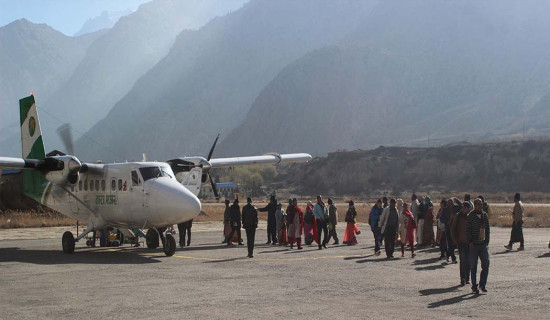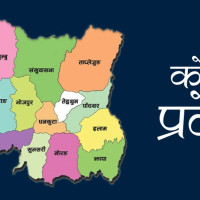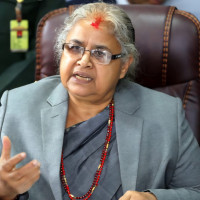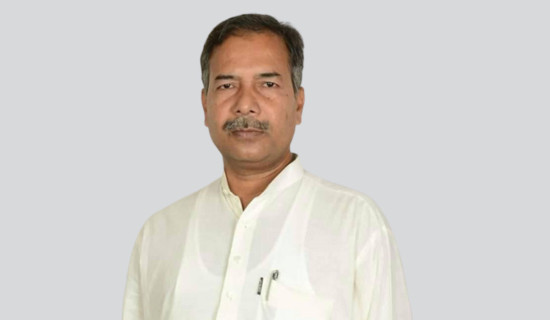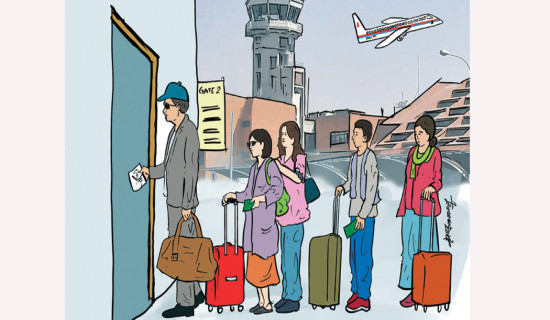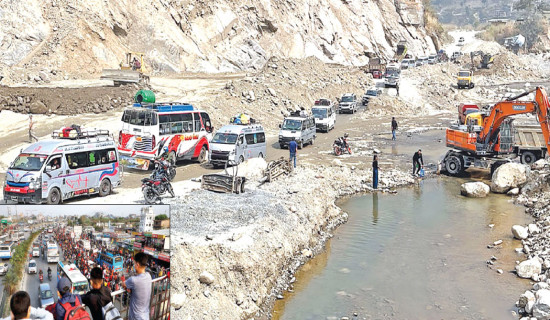- Thursday, 25 December 2025
Dashain travel on sloppy roads is a real ordeal
Kathmandu, Oct. 6: In Kathmandu, the festive ambience of Dashain is gradually returning after being dampened temporarily by heavy, continuous rains that triggered floods and landslides across the country, obstructing roads in various places.
As the Kathmandu-Mugling road reopens and weather conditions improve, the flow of people leaving Kathmandu to celebrate Dashain at their hometowns has started to increase.
At the New Bus Park and various ticket counters, people are lining up to buy tickets and travel to their hometowns. Although transport operators report that ticket sales are lower compared to previous years, people are still seen heading towards their villages as the weather improves day by day.
Thousands of people were seen boarding buses at the New Bus Park to celebrate Dashain by reaching their homes. Their faces reflected excitement and relief, knowing they would now be able to enjoy the festival.
232,445 leave Valley
According to Bharat Bahadur Bohara, Chief of Kathmandu Valley Traffic Police Office and Deputy Inspector General of Police, from the Day of Ghatasthapana (October 3) to October 5 on Saturday, 232,445 people have exited from the Valley. Of them, on Ghatasthapana, 72,037 people by 10,933 vehicles, 78,104 people by 11,834 vehicles on October 4 and 82,304 by 15,334 vehicles (as of October 5, 1:00 pm) have exited Kathmandu.
Superintendent of Police and Spokesperson for the Kathmandu District Police Office, Nabaraj Adhikari, said that the crowd at the New Bus Park has increased as school holidays begin following Ghatasthapana (the first day of Dashain).
"As schools are closing and more people are leaving Kathmandu for their homes, the crowd has increased at the New Bus Park. We have also increased the number of security personnel," he said.
Meanwhile, local authorities are preparing alternative roads in areas where the roads have been damaged.
Since Dashain is a festival of religious, cultural, and family gatherings, people leave big cities like Kathmandu to spend time with their families in their hometowns.
Risky road travel
But for many people, travelling by road is often fraught with risks of accidents. On October 5 only, the third day of formal beginning of Dashain on October 3, a driver of Hilux vehicle (Ba 14 Cha 3855) died in a road accident that took place at Kaphaldanda in Nuwakot while it was heading towards Lamjung via Tokha-Chhahare-Kathmandu road on Saturday morning.
But with a great dismay this time, the incessant rainfall that occurred last Friday and Saturday across the country has made it not only difficult but for many, almost impossible to return to their homes for Dashain festival. A kind of panic has gripped one and all after many roads and highways have still been blocked after the road infrastructures were damaged by the floods and landslides.
The reason is that out of the 80 major highways in the country, five highways are still completely closed two-way, while two highways have reopened for one-way traffic. Similarly, three roads are completely closed as of Saturday morning (October 5), according to an update of the Nepal Police Headquarters.
According to the information, mainly BP Highway in the east has come to a complete halt in four separate places in Roshi Rural Municipality-8 at Charsayabeshi, Roshi Rural Municipality-11 at Kaldhunga, Roshi Rural Municipality-12 at Pyakurel Gaun, and Sunkoshi Rural Municipality-1 along the highway.
Similarly, Araniko Highway (Barhabishe-Tatopani road) and Kanti Lokpath have also been in a complete halt.
Likewise, Sisneri-Dakshinkali road, Bhimphedi-Kulekhani-Phakhel road in the south and Kulekhani-Markhu road have also been in complete obstruction.
Prithvi Highway has opened for one-way traffic from Friday, according to the update.
The continuous rainfall of the last week also claimed 239 lives leaving 177 injured and 18 missing as of Saturday morning. When the road condition could not be maintained accordingly, the number of road accidents might surge during the Dashain holiday.
This is mainly attributed to vehicles carrying passengers beyond their capacity, high speed and reckless driving. The risk is further compounded by the poor state of the road, particularly in the hill and mountain regions.
According to last year's record of public vehicle accidents during Dashain, no single public vehicle met a big road accident and nobody travelling by public vehicle was killed.
However, there had been several accident records belonging to private vehicles, including the casualties, according to police data.
General Secretary for the Federation of Nepali National Transport Entrepreneurs Saroj Sitaula, said the government has a misconception that every road accident is related to public vehicles. On highways, more private vehicles are meeting accidents with fatalities as well. Only few of them are responsible for public vehicles.
"Preparations for Dashain festival are sure to become tough and challenging for both the government and transport entrepreneurs, and those wishing to return to their hometowns are facing increasing challenges because of nation-wide shoddy road condition in the wake of heavy rainfall and flooding," said Sitaula.
He said the continuous rainfall has deteriorated road conditions, making it very difficult for numerous travelers and transport entrepreneurs.
While everyone desires to celebrate the Dashain festival with the family members, it is essential to ensure a safe and smooth journey, said Sitaula.
He also said that ticket buyers for going hometowns this time after heavy rainfall may reduce and this has been noticed in view of the pressure of people buying air tickets and daily tight flight schedules at TIA.
Earlier, the entrepreneurs had expected that 1.8 million people will leave Valley for celebrating festivals with their family members in their hometowns. Sitaula, however, said the number of people leaving hometown by road will now reduce.
Multiple highway sections across Koshi, Bagmati, and Lumbini Province have been affected due to landslides, floods and infrastructure damages, leading to road closure, said Arjun Prasad Aryal, Deputy Director General for the Department of Roads (DoR), who is also the Head of the Road Maintenance Division.
A total of 24 road sections are still affected, including major highways like Mechi, BP, and Araniko. Efforts for road clearance and infrastructure repair are ongoing, said Aryal. The East-West Highway at Bardaghat in Nawalparasi West of Lubmini Province has also been closed until further notice because of road sink, he informed.
Keshav Prasad Ojha, Head of the Eastern Section of the Nagdhunga-Mugling Road Project, said, a total of 44 suspension bridges have been damaged across various rivers and streams during this period. Likewise, 25 bridges were completely damaged and 19 damaged partially.
Sushil Babu Dhakal, Spokesperson for the Ministry of Physical Infrastructure and Transport, said that road infrastructure repair and construction works are actively being carried out across the country. He emphasised that the ministry and its subordinate bodies are seriously committed to ensuring safe transportation management throughout the festive time resulting in cost of Rs. 3 billion to repair roads and highways annually.
Status of highways
According to the statistics of the National Highway of the Department of Roads, there are 80 national highways in Nepal, with a total length of 11,799.09 km.
According to the latest update made by the DoR, 810 total incidents of road obstruction had been reported as of Saturday (October 5) from April 13, 2024. Of them, 30 road sections have come to a complete halt. Similarly, 422 road sections have come to operation one-way while 358 roads have been operating two-way.
Experts’ take
Ashish Gajurel, a transport and traffic consultant and Executive Director of the Nepal Intermodal Transport Development Board (NITDB), pointed out critical flaws in Nepal's approach to road safety. Despite the government allocating around 19 to 20 per cent of its total budget to the Ministry of Infrastructure and Transport, Gajurel believed these funds are not being effectively used to improve road safety.
One of his main concerns is the divided responsibility for road safety, which is spread across various agencies at both the federal and provincial levels. These include the Ministry of Physical Infrastructure and Transport, the Department of Roads, the Department of Transport Management, the Traffic Police, and the Ministry of Home Affairs. With so many institutions involved, no single body is held accountable when serious road accidents with high casualties occur.
Gajurel argued that to effectively reduce accidents, Nepal needs a dedicated road safety act and a national road safety council to oversee all road safety-related issues. This council would have the authority to take charge of road safety efforts and ensure proper governance and accountability.
He stressed the need to focus not just on human error but also on improving road infrastructure and educating drivers and pedestrians about traffic rules. While accidents due to human and mechanical error are inevitable, investing in better infrastructure and road safety education can significantly reduce the risks.
Dr. Pushpa Raj Panta, a long-time advocate for road safety, emphasised the urgent need for the government to develop a concrete plan to improve road safety and protect lives and property.
"Looking at past trends in accidents, our efforts have been insufficient," said Dr. Panta, who is also a researcher at the University of the West of England in Bristol. He pointed out that millions of people, including families and relatives of victims, continue to suffer in the aftermath of road accidents. Despite this, he noted that the government has failed to invest enough in reducing these incidents.
A World Bank study estimates that road accidents cause annual economic losses of about 3 per cent of Nepal’s Gross Domestic Product (GDP). Over the last decade, the number of road fatalities has increased by 34 per cent. Nepal has committed to a United Nations target of halving road fatalities and serious injuries by 2028, using 2018 figures (477 deaths) as a baseline. However, Dr. Panta expressed concern that achieving this goal will be challenging, given the slow progress made by the government.
According to a World Health Organization (WHO) report, around 28 people per 100,000 die in road accidents in Nepal, one of the highest rates in South Asia.
The WHO Southeast Asia Regional Office’s August 2024 report on road safety revealed that Nepal’s performance in road safety indicators is extremely poor. The "East Asia Regional Status Report on Road Safety" highlighted that Nepal has shown the least progress toward the 12 global road safety performance targets compared to other countries in the region.
Data from Nepal Police Headquarters shows that over the last 10 years, around 24,000 people have died in road accidents, with more than 72,000 left seriously injured, many now living with disabilities. The Ministry of Health and Population reports that approximately 100,000 people are injured in road accidents across the country each year and seek medical care.
Between 2018/19 and 2023/24, 172,195 road accidents occurred in Nepal, causing 12,848 deaths and 31,005 injuries. Most of the fatalities involve men, and 1,143 children (758 boys and 385 girls) also lost their lives during this period. In the last fiscal year 2023/24, 2,369 persons were killed and 6,160 were injured while in 2018, 477 persons were killed and 762 were injured in a total of 1,097 road accidents.



